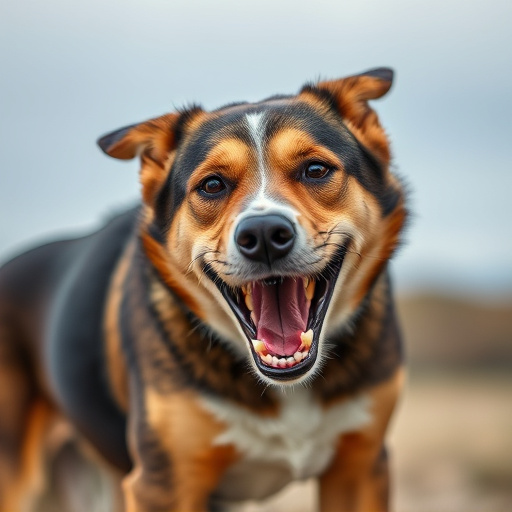Dog aggression issues stem from fear, territoriality, or past trauma. Recognize distress signs for timely intervention. Training, socialization, and positive reinforcement reduce aggression. Neutralizing mace spray disrupts senses during attacks, offering temporary safety. Choose vet-approved animal-specific pepper sprays, practice safe application on pet skin, and train for future de-escalation.
In the face of rising dog attacks, understanding and preventing aggressive behavior is paramount. This article explores an innovative solution: stop dog attack pepper spray. We delve into the science behind dog aggression and its triggers, highlighting how neutralizing mace spray can be a game-changer. Learn about effective application techniques and post-exposure care to ensure safe interactions with pets. Discover the right mace for your pet’s skin, empowering you to protect yourself and your loved ones from potential harm.
- Understanding Dog Aggression and Its Triggers
- The Role of Pepper Spray in Dog Attack Prevention
- Choosing the Right Neutralizing Mace for Pets
- Application Techniques to Effectively Deploy Pepper Spray
- Post-Exposure Care and Training Strategies
Understanding Dog Aggression and Its Triggers
Dog aggression can stem from various triggers, and understanding these is key to preventing attacks. Factors like fear, territorial behavior, or past trauma can lead to aggressive responses. Recognizing signs of distress in dogs, such as raised fur, growling, or a rigid stance, is crucial for intervention. Training, socialization, and consistent positive reinforcement can help mitigate aggression.
When dealing with an aggressive dog, using a neutralizing mace spray designed for pets can provide a temporary safety measure. These sprays are formulated to disrupt the dog’s sense of smell without causing permanent harm, allowing time for a safe escape or professional intervention. Always choose a product specifically designed for animals and follow instructions carefully to ensure both pet safety and effective neutralization.
The Role of Pepper Spray in Dog Attack Prevention
Pepper spray, also known as capsaicin spray, has established itself as a valuable tool in dog attack prevention. When used correctly, it can effectively deter aggressive behavior and help to neutralize potential threats. The primary function of pepper spray is to irritate the eyes, nose, and throat of both dogs and humans, causing temporary disorientation and pain. This disruption is crucial in giving the user time to escape or de-escalate the situation.
In terms of application, neutralizing mace spray on pet skin should be a top priority during an attack. It’s important to aim for the dog’s face, as this area has a high concentration of sensory receptors. However, it’s crucial to use these sprays responsibly and only as a last resort, as they can also cause harm to humans if misused or in proximity to sensitive areas like eyes and mouth. Proper training and understanding of dosage are essential to ensure safety for both pets and people alike.
Choosing the Right Neutralizing Mace for Pets
When selecting a dog attack pepper spray, or neutralizing mace spray, for your pet’s safety, it’s crucial to consider factors beyond just its effectiveness. The skin sensitivity and overall health of your pet are essential variables. Opting for a spray formulated specifically for animals can help ensure it’s gentle enough not to irritate or damage their delicate skin. Look for products designed with vet-approved ingredients that quickly neutralize without causing prolonged discomfort or harm.
Additionally, the delivery system should be easy to control and use in emergency situations. Streamlined, ergonomic designs allow for precise application, enabling you to target aggressive dogs effectively while minimizing any collateral damage to your pet’s fur or surrounding areas. Always review safety guidelines and instructions before purchasing to make an informed decision tailored to your pet’s needs.
Application Techniques to Effectively Deploy Pepper Spray
When using pepper spray, or Neutralize Mace Spray, on a dog’s skin during an attack, proper application technique is crucial for effectiveness. Hold the can upright and target specific areas like the face, eyes, nose, and mouth, where it will cause the most discomfort and temporarily neutralize the animal. Aim for direct contact with the skin to ensure maximum impact, but be cautious not to spray too close to avoid inhalation issues.
Remember that pepper spray works by irritating the dog’s respiratory system and sensory organs, so aiming at these areas is key. Practice your technique in a safe environment to become comfortable with the can’s range and effect. Additionally, always consider the dog’s size and behavior; smaller dogs might require a more targeted approach, while larger ones may need a slightly different angle or distance to ensure successful neutralization without causing excessive panic or injury.
Post-Exposure Care and Training Strategies
After a dog attack, proper post-exposure care is essential to ensure your pet’s recovery and prevent future incidents. The first step is to immediately wash the affected area with mild soap and water to remove any remaining pepper spray residue. It’s crucial to handle the skin gently and avoid rubbing, as this can cause further irritation.
Training plays a significant role in managing dogs that have shown aggressive behavior. Positive reinforcement training techniques can help neutralize fear and anger, replacing them with calmness. Teach your pet basic commands like “sit,” “stay,” and “come” to regain control during potentially stressful situations. Consistent and patient training sessions will enable your dog to associate certain commands with safety and relaxation, thereby reducing the likelihood of an attack. Additionally, enrolling in professional behavior modification classes can provide specialized guidance tailored to your pet’s unique needs.
In conclusion, understanding dog aggression and its triggers is key to preventing attacks. Pepper spray, specifically designed for neutralizing dog skin, can be a powerful tool in these situations. By choosing the right neutralizing mace and learning effective application techniques, you can protect yourself and your loved ones. After an exposure, post-care and training strategies further enhance safety. Remember, proper preparation and swift action with pepper spray can make all the difference when facing an aggressive dog.
